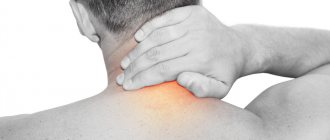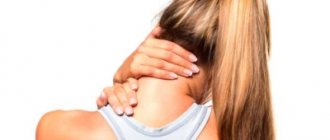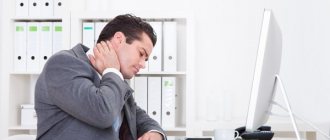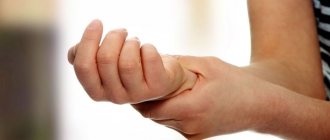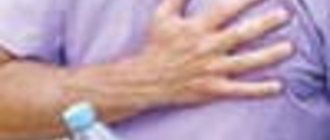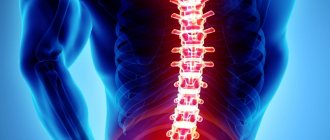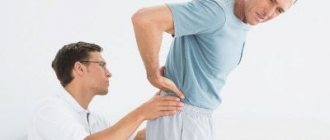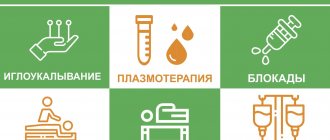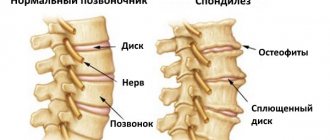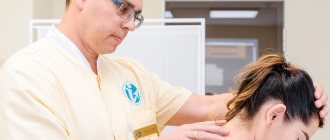08 October 2021
According to the International Classification of Diseases, osteochondrosis is included in the group of diseases of the musculoskeletal system, mainly the spine, and connective tissue
According to the International Classification of Diseases, osteochondrosis is included in the group of diseases of the musculoskeletal system, mainly the spine, and connective tissue. Wearing out, collapsing and flattening over time, the intervertebral disc loses its shock-absorbing and protective function. The intervertebral space narrows, where the radicular nerves and blood vessels become compressed. This leads to various unpleasant symptoms, which force a person to see a doctor.
Based on localization, they distinguish between cervical, thoracic, lumbar, sacral and widespread osteochondrosis. The most commonly diagnosed osteochondrosis is lumbar osteochondrosis (over 50% of cases), cervical (over 25%) and widespread (about 12%).
How does osteochondrosis develop?
The human spine consists of 33-35 vertebrae.
Between them are elastic intervertebral discs. They strengthen the spinal column, making it elastic and mobile. Each intervertebral disc consists of a nucleus pulposus, which is contained within a hard annulus fibrosus. They are covered above and below with hyaline cartilage. With osteochondrosis, metabolism and blood circulation in the spine are disrupted. At the initial stage of osteochondrosis, intervertebral discs lose strength and elasticity and dry out. The height of the intervertebral discs decreases. The fibrous ring of the disc ceases to withstand the load on the spine and begins to bulge and crack. When the fibrous ring ruptures, an intervertebral hernia is formed. Osteochondrosis of the back can lead to curvature of the entire spine and loss of mobility.
Treatment methods for osteochondrosis
The degree and type of osteochondrosis determines which treatment methods the doctor will choose. In particularly advanced cases, surgical intervention will be required. However, the disease is usually successfully managed with medication. Additionally, magnetic and ultrasound physiotherapy, electrophoresis, massages, therapeutic exercises and much more are used.
In our clinic you can undergo a rehabilitation course for osteochondrosis under the supervision of experienced doctors. We will do everything possible to cure osteochondrosis without surgery.
Causes of osteochondrosis
Our spine is designed for an active lifestyle. He needs moderate exercise, but overexertion is harmful. The main causes of osteochondrosis include:
- injuries and congenital defects of the spine;
- genetic predisposition;
- metabolic disorders, obesity;
- infectious diseases;
- aging of the body;
- constant overload of the spine due to sports or heavy physical labor;
- exposure to chemicals;
- constant vibrations - for example, among truck drivers or drivers of agricultural machinery;
- flat feet;
- posture disorders.
Risk factors for the occurrence of osteochondrosis are:
- poor nutrition, excess weight;
- sedentary lifestyle;
- working at a computer and constantly driving a car;
- smoking;
- intensive training in the gym;
- incorrect posture;
- hypothermia;
- wearing uncomfortable shoes, high heels;
- constant stress, smoking.
Loaders, weightlifters, builders, and gymnasts are susceptible to osteochondrosis. People who worry a lot, often walk with their heads and shoulders down, are also at risk of developing osteochondrosis.
Classification
There are four degrees of osteochondrosis. Classification occurs on the basis of the collected history and with the help of instrumental diagnostic methods. The main criteria in this classification are pain and neurological symptoms.
- I degree - pain is easily relieved with medication.
- II degree - characterized by prolonged pain and deformation of the spine with moderate neurological symptoms.
- III degree - pain is systematic, neurological symptoms are significant.
- IV degree - constant pain, multiple neurological deficits. Disturbance in the conduction of nerve impulses. Paralysis and paresis.
In case of widespread dysplastic osteochondrosis, the patient is assigned disability status. Depending on the general condition of the patient, the degree and intensity of the development of the clinical picture, disability can be of three groups.
There are several degrees of osteochondrosis
Table No. 1. Types of disability in osteochondrosis.
| Group | Description |
| First group | The functions of the spine are lost. The patient is unable to move independently and take care of himself. |
| Second group | The patient is able to move around and carry out small tasks, but periods of exacerbation are frequent. The operation is contraindicated or useless for some reason. Or surgery has already been performed, but turned out to be ineffective. |
| Third group | The patient is capable of self-care. There are pain and vestibular symptoms, but the frequency of exacerbations is moderate and periodic. |
The disability group is assigned by the doctor based on some studies to assess the ability to work.
Types of osteochondrosis
There are several types of disease:
- Lumbar osteochondrosis is the most common type of disease. This is explained by the large load that falls on the lumbar region. Lumbar intervertebral osteochondrosis can lead to scoliosis or intervertebral hernia.
- Osteochondrosis of the cervical spine is the second most common type of disease. It often occurs due to working at a computer or driving a car. The muscles of the cervical region are poorly developed, so even a slight load on the neck can cause displacement of the vertebrae.
- Osteochondrosis of the thoracic region is the least common, because the thoracic spine is the least mobile and is well protected by the ribs and muscle corset. Thoracic osteochondrosis often occurs due to scoliosis. The disease is difficult to diagnose, as its symptoms are easily confused with signs of other diseases.
- Common spinal osteochondrosis affects simultaneously two or all three parts of the spinal column.
Classification by clinical manifestations
This type of classification is based on clinical studies of the patient. It has four stages:
- Stage 1. The spine continues to function as usual, but the person feels slight pain at the site of the disease.
- Stage 2. Pinched nerves, protrusion, and subluxation of the vertebrae begin, and the pain becomes stronger.
- Stage 3. The pain intensifies, spinal deformation occurs, and vertebral disc herniation occurs.
- Stage 4. The spine loses mobility, pain occurs with any movement, the patient walks with great difficulty.
After diagnosing the fourth stage, the patient receives disability.
Symptoms of osteochondrosis
Symptoms of the disease depend on which part of the spine suffers from osteochondrosis.
Symptoms of lumbar osteochondrosis include:
- constant aching or acute pain in the lower back;
- pain increases with physical activity or movement;
- pain can radiate to the sacrum, legs, pelvic organs;
- loss of sensation in the legs;
- Often a person cannot turn or bend over. He maintains the same position in which he feels the least pain.
Signs of cervical osteochondrosis:
- headaches that worsen with movement and do not go away after analgesics;
- dizziness when turning the head suddenly;
- pain in the arms, shoulders and chest;
- “floaters” and colored spots before the eyes;
- deterioration of vision and hearing, “ringing” in the ears;
- occasionally numbness of the tongue, change in voice.
Thoracic osteochondrosis has the following symptoms:
- pain in the chest and between the shoulder blades, when raising the arm, bending over;
- the pain is felt more strongly at night, during hypothermia, turning, or heavy physical activity;
- painful sensations intensify with deep inhalation and exhalation;
- numbness of certain areas of the skin, “goosebumps”;
- itching, burning, feeling of cold in the legs;
- attack of pain between the ribs while walking;
- sensation as if chest were being squeezed by a hoop.
Prevention of osteochondrosis.
The main recommendation for those who want to maintain the health of the osteoarticular system is an orthopedic regimen. It is important to learn how to sit correctly, stand correctly, lift and carry heavy objects, and sleep. For example, the patient is advised to avoid upholstered furniture, including for sleeping. The work chair should have lumbar support. It is not recommended to stand in one position for a long time; it is advisable to periodically warm up. It is not recommended to lift and carry things weighing more than 15 kilograms. Every morning it is recommended to do short exercises for 15-30 minutes to pre-warm up the muscles.
Back to articles
Stages of osteochondrosis
At the first stage of osteochondrosis, the intervertebral discs lose their elasticity, their height decreases, and they begin to bulge. A person feels slight stiffness in the back in the morning.
The manifestation of osteochondrosis at the second stage is pain in the spine. At this stage, cracks appear in the fibrous ring and vertebral instability occurs. An attack of osteochondrosis causes severe acute pain. Due to the exacerbation, the person cannot move freely.
The third stage of the disease is accompanied by rupture of the fibrous ring. The semi-fluid core of the intervertebral disc enters the spinal canal. An intervertebral hernia forms. If the disease is not treated, a hernia can lead to disability.
Osteocondritis of the spine. Causes and symptoms, treatment
Osteochondrosis of the spine is a multifactorial degenerative-dystrophic disease of the vertebral motion segment, affecting primarily the intervertebral disc, and secondarily other parts of the vertebral motion segment, the musculoskeletal system, the nervous system, and blood vessels. If you imagine the spinal column as a stack of bricks, then each brick will correspond to a functional unit of the spinal column - a vertebral motor segment. Vertebral - motion segment is two adjacent vertebrae connected by an intervertebral disc and surrounding muscles and ligaments. We usually learn that the disease has already begun when back pain, muscle tension, and limited mobility of the spine appear.
Who suffers from osteochondrosis?
Nowadays, osteochondrosis affects from 40 to 90% of the world's population. Most often, the disease affects people over 30 years of age. However, the first symptoms of osteochondrosis may appear in adolescence.
Stages of development of spinal osteochondrosis.
1. The first stage of development of osteochondrosis.
Dehydration (loss of fluid) of the nucleus pulposus begins. This leads to a decrease in the height of the disk. Cracks appear in the fibrous ring, but the pathological process does not extend beyond the intervertebral disc.
2. The second stage of development of osteochondrosis.
As a result of a decrease in the height of the disc, the attachment points of muscles and ligaments belonging to two adjacent vertebrae come closer together. Therefore, muscles and ligaments sag. This can lead to excessive mobility of the two vertebrae relative to each other, i.e. Instability of the vertebral - motion segment is formed. At this stage, slipping or displacement of the vertebrae relative to each other with the formation of spondylolisthesis is characteristic.
3. The third stage of development of osteochondrosis.
At this stage, first of all, the intervertebral discs themselves suffer and disc protrusions (protrusion and hernia) are formed, and the articular apparatus of the vertebral motion segment also suffers. During this period, the most pronounced morphological changes in the motor segment occur. Subluxations occur in the intervertebral joints and arthrosis forms.
4. The fourth stage of development of osteochondrosis.
At this stage, adaptive changes occur in the affected segments of the spine. The body tries to overcome excessive mobility of the vertebrae and immobilize the spine to preserve its supporting and protective functions. In this regard, marginal bone growths appear on adjacent surfaces of the vertebral bodies, in other words, osteophytes. An osteophyte that grows “in the wrong place” causes microtrauma to the nerve root. At the fourth stage, processes of fibrous ankylosis usually begin in the intervertebral discs and joints. Ultimately, the vertebral motor segment appears to be immured in a shell, and the clinical manifestations subside.
Causes of spinal osteochondrosis.
In each of the many existing theories of the development of osteochondrosis, various reasons are identified that contribute to the onset of the disease, for example, mechanical trauma, hereditary predisposition or metabolic disorders. A particular difficulty in determining the cause of osteochondrosis is due to the fact that this disease can occur in both elderly and young people, both in well-built and less trained people. There is a widespread false belief that the cause of osteochondrosis is “deposition of salts” in the spine: supposedly on X-rays, “salts” can be seen in the form of “growths” or “hooks” on the vertebrae. If, when moving, there is a crunching and creaking sensation in the joints, as if sand had been poured between them, for many patients the only explanation for this condition is the notorious “salt deposits.” The term "osteochondrosis" comes from the Greek roots osteon - "bone" and chondr - "cartilage". The ending “-oz” means that the disease of bone and cartilage is not associated with inflammatory processes, but is degenerative-dystrophic in nature, that is, the basis of the disease is a violation of tissue nutrition and, as a consequence, degeneration of its structure. Like all living tissues, the bone tissue of the vertebrae and the cartilage tissue of the intervertebral discs are constantly rebuilt and self-renewing. Under the influence of regularly exerted physical activity, they acquire strength and elasticity, and in the absence of loads, the strength of the tissues decreases. This is due to the peculiarities of nutrition and blood supply to bone and cartilage tissue. The discs of adults do not have their own vessels; they receive nutrients and oxygen from neighboring tissues. Therefore, for proper nutrition of the discs, it is necessary to activate blood circulation in the tissues surrounding the discs. And this can only be achieved through intense muscle work. Based on its composition, the intervertebral disc can be divided into two parts: it is the nucleus pulposus, which gives elasticity to the disc, located in the center and a strong fibrous ring surrounding it. Due to deterioration in the nutrition of the intervertebral discs, the complex structure of biopolymer compounds that make up the nucleus pulposus is destroyed. The moisture content in the nucleus pulposus decreases and it becomes more fragile. When exposed to even minor overloads, the nucleus pulposus can disintegrate into fragments. This leads to a decrease in its elasticity to an even greater extent. There is also a decrease in the strength of the fibrous rings of the discs. To restore the function of the spine, it is necessary to scar the damaged intervertebral disc, mobilize the compensatory capabilities of the spine, as well as the musculoskeletal system as a whole, and not resolve “salt deposits” or eliminate “spikes” on the vertebrae. When performing an X-ray examination after the end of treatment, you can see that the vertebrae have not changed their shape. And the notorious “spikes” are not the cause of osteochondrosis, but a consequence of adaptive processes. Marginal growths increase the area of the supporting surface of the vertebral body. Due to the increase in area, the specific pressure decreases, which makes it possible to compensate for the decrease in the strength and elasticity of the intervertebral disc. Degenerative-dystrophic changes occurring in the spine are accompanied by calcification (calcification) of damaged discs, individual sections of articular ligaments, cartilage, and capsules. This process can only be called deposition of salts conditionally. Thus, this is not the cause of osteochondrosis, but only a consequence and the final stage of the process described above. Reversal of structural changes in the spine is almost impossible. But minimizing them is a very real task. If no effort is made to maintain the spine in the same condition that was achieved as a result of treatment, the pain may recur.
Clinical manifestations of spinal osteochondrosis.
Clinical manifestations of osteochondrosis are very diverse, they depend on the stage of development of osteochondrosis. The main clinical symptoms of osteochondrosis occur when the pathological process spreads to the posterior part of the fibrous ring and the posterior longitudinal ligament. Depending on the stage of degeneration of the intervertebral discs, irritation, compression or disruption of the conductivity of the spinal cord roots, compression of blood vessels or the spinal cord occurs. Various neurological syndromes develop - reflex and compression. The main cause of pain in osteochondrosis is irritation of the nerve root. In this case, circulatory disturbance occurs, swelling occurs, and fibrosis of the surrounding structures may subsequently develop, which is accompanied by an increase in the sensitivity of the roots to various influences (movements in the affected segment of the spine, etc.). Vascular disorders in osteochondrosis are often associated with impaired vasomotor innervation. Mechanical compression of vessels by osteophytes is also possible, for example in the cervical spine.
One of the characteristic features of spinal osteochondrosis is the breadth of its symptoms. This may include pain in the spine and limbs, muscle pain, muscle tension, limited mobility of the spine and joints, and signs of suffering in internal organs. The pain may radiate to the arm or leg, weakness in the limbs, headaches, dizziness, and urinary disorders may appear. Thus, a careful analysis of your condition and the changes occurring in the body is important. It is necessary to consult a doctor in a timely manner, undergo the necessary examination, establish a diagnosis and begin treatment under the supervision of the attending physician. The first symptoms of spinal osteochondrosis include, first of all, pain and discomfort in the back. At the same time, pain can be periodic, appearing and disappearing. But the very first feeling of discomfort or pain in the spine should alert you. When pain appears, try to remember the situation in which it appeared. Such a reason could be lifting a heavy object, sudden movement, falling, etc. To summarize, we can say that the main symptoms of osteochondrosis include pain and discomfort in the back, muscle tension, and limited mobility of the spine.
Diagnosis of spinal osteochondrosis.
To correctly diagnose spinal osteochondrosis, it is necessary to clarify complaints, the history of the development of suffering, conduct a detailed objective examination, including orthopedic and neurological, and prescribe X-ray and MRI examinations. The most accessible method is x-ray examination. Most often, targeted radiography is performed - based on the symptoms of the disease and the patient’s complaints and an objective examination, the location of the spinal lesion is determined. On an x-ray, you can see a decrease in the height of the intervertebral discs, sclerosis of the end plates, the appearance of bone outgrowths of the vertebral bodies, partial dissolution of the bone tissue of the vertebral body, changes in the curvature of the spine, limited or increased mobility of the spine. Computed tomography and magnetic resonance imaging are the most modern, but also the most expensive methods for diagnosing osteochondrosis. These diagnostic methods are usually used when it is necessary to make a differential diagnosis between osteochondrosis and other diseases of the spine that have similar symptoms, to exclude tumors, and to confirm the presence of a disc herniation.
Treatment of spinal osteochondrosis.
The main objectives in the treatment of spinal osteochondrosis are the fastest relief of pain, relief of inflammation, muscle spasm, restoration of the function of the spinal motion segment, further rehabilitation in order to form a full-fledged muscle corset and prevent exacerbation. Drug treatment includes the prescription of non-steroidal anti-inflammatory drugs, painkillers, drugs that relieve muscle spasms; in the presence of disc-radicular conflict, anticonvulsants are used, and physiotherapeutic treatment is prescribed. After pain reduction, manual therapy, massage. From the first days, physical therapy is prescribed, later swimming, constant physical therapy, and kinesiotherapy. The further prognosis largely depends on the patient, how hard he engages in physical therapy and how correctly he behaves.
Complications of osteochondrosis
Without timely treatment, osteochondrosis of the back leads to serious complications: radiculitis, protrusion of the intervertebral disc, intervertebral hernia. A hernia in any part of the spine can damage the spinal cord and cause paralysis of certain parts of the body.
Over time, hypertension and hypotension, and vegetative-vascular dystonia may join osteochondrosis. The risk of heart attack and stroke increases.
Severe consequences of thoracic osteochondrosis are intercostal neuralgia, problems with the heart, stomach, intestines, liver, kidneys and pancreas.
Lumbar osteochondrosis can lead to sciatica - inflammation of the sciatic nerve. At the same time, the person has severe pain in the leg and lower back. The disease often causes chronic inflammation of the pelvic organs. In women this leads to infertility, in men - to impotence.
The most dangerous complication of cervical osteochondrosis is compression of the vertebral arteries. They provide one third of the brain’s nutrition. Impaired blood supply to this area can cause problems with the cardiovascular and respiratory systems, hearing, vision, and coordination.
general characteristics
Osteochondrosis is a degenerative disease of the spine, which most often affects the thoracic, lumbar and cervical regions. This pathology has a direct correlation with age. The disease is much more common in people over 40 years of age, but recently there has been a trend towards rejuvenation. Common osteochondrosis differs in that it affects more than one section of a department or several departments at once. Due to the progressive development of degenerative processes not only in bone tissue, but also in the ligamentous apparatus of the spine, the vertebrae become mobile and put pressure on the nerves and blood vessels. The symptoms of common osteochondrosis are associated with this, but it is noteworthy that the disease can be asymptomatic for some time.
Common osteochondrosis is a pathology that affects several areas of one part of the spine or several parts at once.
Important! The pathology requires multidisciplinary control, since it affects not only the musculoskeletal system, but also the nervous system, as well as internal organs. In addition to the spine itself, the pathological process can also affect other elements of the skeleton.
Psychosomatics of osteochondrosis
Psychosomatic causes of pathology are a new direction in the search for prerequisites for its formation. Psychosomatics implies the influence of psychological factors on the development and course of physical illness. The connection between physical and mental problems is really close, and a seemingly healthy person can suffer from regular pain. With osteochondrosis, in some people there are no objective reasons for the pathology, but it continues to progress.
Up to 30% of patients after a visit to the doctor indicate such troubles as:
- Constant stress;
- Chronic experiences;
- Nervous tension;
- Family problems;
- Conflicts;
- Moral breakdown.
In this case, psychosomatics in the appearance of spinal lesion syndrome is clearly visible - the person “bends” under the weight of problems, which causes the spine to suffer. If the pathology has similar causes, treatment of osteochondrosis will be difficult; medications usually do not help. Exacerbations of pathology occur during a new wave of stress, and there are no physical reasons for them.
Psychosomatics especially often affects the cervical spine, but the pain syndrome can range throughout the entire spinal column. Treatment of osteochondrosis should begin with searching for and solving psychological problems under the supervision of a psychotherapist.
Possible complications
If you do not start treating the pathological process in time, it will not go away on its own. Using traditional methods or painkillers will also not solve the problem. Therefore, all patients who are postponing a visit to the doctor should know the dangers of the advanced process:
- Acute dysfunction of the genitourinary system.
- Liver or kidney diseases.
- Disorders of the respiratory system.
- A variety of heart failures.
- Slowing metabolism.
- Atrophic processes in joints, decreased elasticity of muscle fiber.
- Premature aging of connective tissue.
- Constant exacerbations of pathology.
- Intervertebral hernia.
The danger of the disease is that it quickly progresses and spreads to nearby joints. For example, from the lumbar region it easily migrates to the pelvis and legs. Timely initiation of therapy will increase the chances of effectively slowing down the process, relieving unpleasant symptoms and maintaining a high quality of life. In advanced cases, patients are assigned a disability, as many lose the ability to care for themselves.
Treatment
Treatment of common osteochondrosis usually includes only conservative methods. Treatment is demanding of the patient's efforts. Activities such as physical therapy for common types of osteochondrosis require diligence. Treatment depends on how many departments are affected by the pathology. Therapy takes place in several stages. The first stage is medication.
Painkillers, injectable and orally; If this does not help, a local spinal block with Novocaine is done; When the pain syndrome is relieved, you need to begin treating the inflammatory process. Nonsteroidal anti-inflammatory drugs (the most common are Ibuprofen and Diclofenac) will best help with this; To relieve muscle tension, muscle relaxants such as Mydocalm or Sirdalud are taken
They have a large number of side effects and should be taken carefully under the supervision of a doctor.
In addition, chondroprotectors (Chondrolon or Protekon) are used. They help regenerate cartilage tissue. This is what intervertebral discs are made of.
To improve the patient's neurological condition, antidepressants are sometimes prescribed. Injections with B vitamins and vitamin-mineral complexes in tablets will strengthen the body’s defense against inflammation, improve blood circulation, and restore muscle tone.
In a therapist’s office you can get rid of pain from widespread osteochondrosis and overcome the inflammatory process. Strengthen the cartilage tissue of the intervertebral discs. The following therapeutic procedures are prescribed:
- Ultrasound treatment;
- Magnetic fields;
- Directional laser;
- Low frequency electric current;
- Electrophoresis.
An experienced chiropractor will be able to release pinched nerves and expand the space for intervertebral discs. Free from vertebral pressure, the discs will be able to restore metabolic processes and a healthy structure. But manual therapy has many contraindications. Ask your doctor about them, read reviews about the work of a particular chiropractor before visiting his office.
Exercise therapy during remission of common osteochondrosis is the best way to prevent a relapse of the acute period. Do not perform exercises that cause discomfort or if pain begins. If possible, exercise under the supervision of a physical therapist. Do not perform exercises with sudden movements. We offer you the simplest exercises for the treatment of common osteochondrosis:
- Stand up and alternately tilt your head to the sides, pausing at the lowest point for five seconds. Do ten repetitions;
- Rotate your shoulders forward and backward. Do ten repetitions;
- Bend your whole body to the sides several times.
In 95% of cases, doctors try to limit therapy with conservative methods. But sometimes complications of common osteochondrosis force one to resort to surgical intervention. For example, hernias in different parts of the spine, stenosis of the spinal canal.
If hernias occur that put pressure on the spinal cord, the released cartilage tissue is burned out with a laser or pumped out. The operation is traumatic and requires a long recovery period. Therefore, you should not get carried away with self-medication; at the first manifestations of widespread osteochondrosis, consult a doctor.
Causes and mechanism of development
At the base of the intervertebral disc is the nucleus pulposus, which provides flexibility to the spine and plays the role of a shock absorber. Under the influence of unfavorable static and dynamic loads, processes of polysaccharide depolymerization begin in it, as a result of which it gradually loses its physiological properties. Areas of dead tissue begin to appear in it. The fibrous ring surrounding the nucleus pulposus begins to bulge under the influence of physical activity, which is regarded by doctors as the initial form of intervertebral hernia.
To study Rehabilitation after removal of a hernia of the lumbar spine
Instability of the spinal segment is accompanied by the development of reactive changes both from the adjacent vertebral bodies themselves and from the intervertebral joints, ligaments, and muscles.
All this leads to the development of a number of syndromes in the patient:
| Syndrome | Description |
| Compression | Its occurrence is caused by compression, tension or deformation of the substance of the spinal cord or nerve roots, blood vessels |
| Reflex | When a nerve root is irritated, a reflex tension occurs in the muscles it innervates. This is accompanied by the appearance of dystrophic, vascular and muscular-tonic disorders |
| Myoadaptive | Manifests itself as discoordination motor reactions, that is, a violation of the tone of individual muscle groups |
